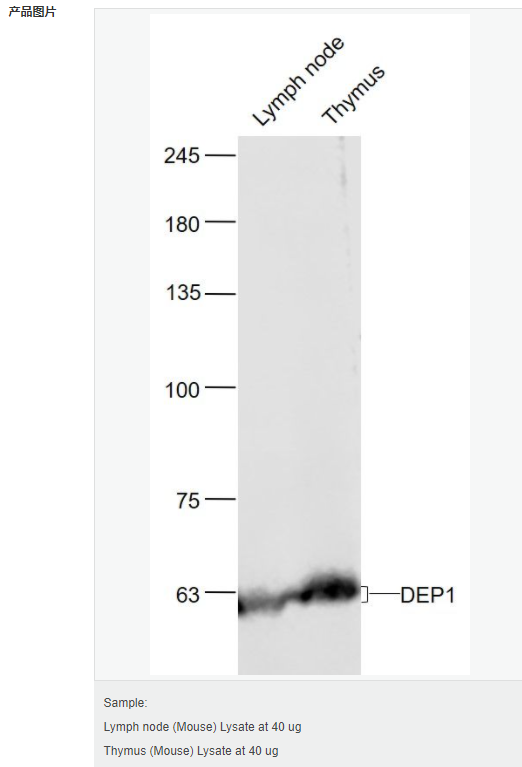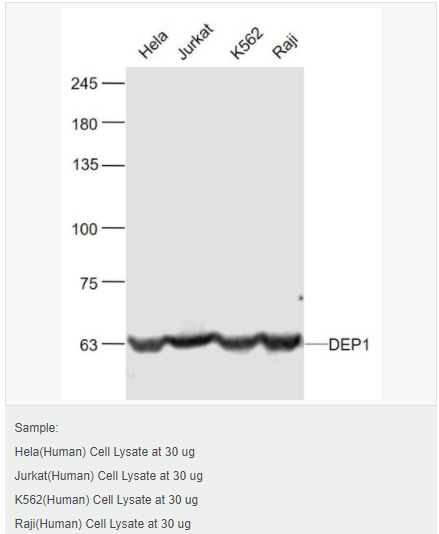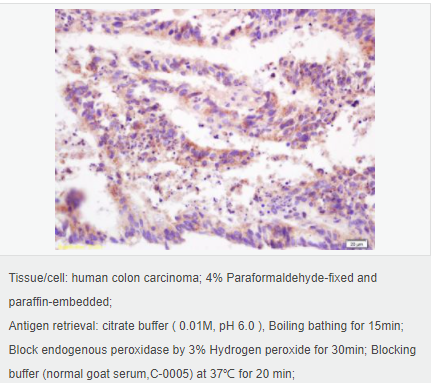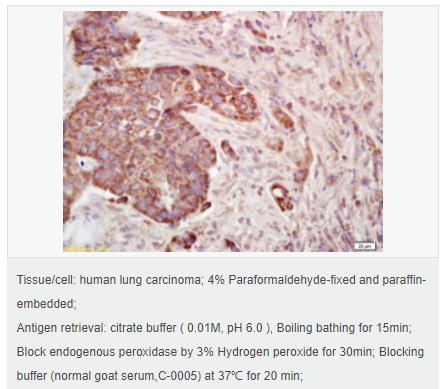

貨號
產(chǎn)品規(guī)格
售價
備注
BN40824R-100ul
100ul
¥2360.00
交叉反應(yīng):Human,Mouse(predicted:Rat,Rabbit) 推薦應(yīng)用:WB,IHC-P,ELISA
BN40824R-200ul
200ul
¥3490.00
交叉反應(yīng):Human,Mouse(predicted:Rat,Rabbit) 推薦應(yīng)用:WB,IHC-P,ELISA
產(chǎn)品描述
| 英文名稱 | DEP1 |
| 中文名稱 | 蛋白酪氨酸磷酸酶CD148抗體 |
| 別 名 | CD 148; CD148; CD148 antigen; Density enhanced phosphatase 1; Density-enhanced phosphatase 1; DEP 1; DEP-1; HPTP eta; HPTPeta; Human density enhanced phosphatase 1; Protein tyrosine phosphatase eta; Protein tyrosine phosphatase receptor type J; Protein tyrosine phosphatase receptor type J polypeptide; Protein-tyrosine phosphatase eta; Protein-tyrosine phosphatase receptor type J; PTPJ; Ptprj; PTPRJ_HUMAN; R PTP Eta; R-PTP-eta; R-PTP-J; Receptor type tyrosine protein phosphatase eta; Receptor-type tyrosine-protein phosphatase eta; SCC 1; SCC1. |
| 研究領(lǐng)域 | 細胞生物 信號轉(zhuǎn)導(dǎo) 激酶和磷酸酶 |
| 抗體來源 | Rabbit |
| 克隆類型 | Polyclonal |
| 交叉反應(yīng) | Human, Mouse, (predicted: Rat, Rabbit, ) |
| 產(chǎn)品應(yīng)用 | WB=1:500-2000 ELISA=1:5000-10000 IHC-P=1:100-500 (石蠟切片需做抗原修復(fù)) not yet tested in other applications. optimal dilutions/concentrations should be determined by the end user. |
| 分 子 量 | 147kDa |
| 細胞定位 | 細胞膜 |
| 性 狀 | Liquid |
| 濃 度 | 1mg/ml |
| 免 疫 原 | KLH conjugated synthetic peptide derived from human PTPRJ:865-970/1337 <Extracellular> |
| 亞 型 | IgG |
| 純化方法 | affinity purified by Protein A |
| 儲 存 液 | 0.01M TBS(pH7.4) with 1% BSA, 0.03% Proclin300 and 50% Glycerol. |
| 保存條件 | Shipped at 4℃. Store at -20 °C for one year. Avoid repeated freeze/thaw cycles. |
| PubMed | PubMed |
| 產(chǎn)品介紹 | The protein encoded by this gene is a member of the protein tyrosine phosphatase (PTP) family. PTPs are known to be signaling molecules that regulate a variety of cellular processes, including cell growth, differentiation, mitotic cycle, and oncogenic transformation. This PTP possesses an extracellular region containing five fibronectin type III repeats, a single transmembrane region, and a single intracytoplasmic catalytic domain, and thus represents a receptor-type PTP. This protein is present in all hematopoietic lineages, and was shown to negatively regulate T cell receptor signaling possibly through interfering with the phosphorylation of Phospholipase C Gamma 1 and Linker for Activation of T Cells. This protein can also dephosphorylate the PDGF beta receptor, and may be involved in UV-induced signal transduction. Multiple transcript variants encoding different isoforms have been found for this gene. [provided by RefSeq]. Function: Tyrosine phosphatase which dephosphorylates or contributes to the dephosphorylation of CTNND1, FLT3, PDGFRB, MET, RET (variant MEN2A), KDR, LYN, SRC, MAPK1, MAPK3, EGFR, TJP1, OCLN, PIK3R1 and PIK3R2. Plays a role in cell adhesion, migration, proliferation and differentiation. Involved in vascular development. Regulator of macrophage adhesion and spreading. Positively affects cell-matrix adhesion. Positive regulator of platelet activation and thrombosis. Negative regulator of cell proliferation. Negative regulator of PDGF-stimulated cell migration; through dephosphorylation of PDGFR. Positive regulator of endothelial cell survival, as well as of VEGF-induced SRC and AKT activation; through KDR dephosphorylation. Negative regulator of EGFR signaling pathway; through EGFR dephosphorylation. Enhances the barrier function of epithelial junctions during reassembly. Negatively regulates T-cell receptor (TCR) signaling. Upon T-cell TCR activation, it is up-regulated and excluded from the immunological synapses, while upon T-cell-antigen presenting cells (APC) disengagement, it is no longer excluded and can dephosphorylate PLCG1 and LAT to down-regulate prolongation of signaling. Subunit: Monomer. Interacts with CTNNB1 (phosphorylated) and JUP (phosphorylated). Interacts with FLT3 (phosphorylated). Interacts with GAB1 and GRB2. Subcellular Location: Cell membrane. Tissue Specificity: Expressed in the promyelocytic cell line HL60, the granulocyte-macrophage colony-stimulating factor-dependent leukemic cell line F-36P, and the interleukin-3 and erythropoietin-dependent leukemic cell line F-36E. Expressed predominantly in epithelial cells and lymphocytes. Enhanced expression at high cell density. Post-translational modifications: N- and O-glycosylated. Similarity: Belongs to the protein-tyrosine phosphatase family. Receptor class 3 subfamily. Contains 9 fibronectin type-III domains. Contains 1 tyrosine-protein phosphatase domain. SWISS: Q12913 Gene ID: 5795 Database links: Entrez Gene: 5795 Human Omim: 600925 Human SwissProt: Q12913 Human Unigene: 318547 Human Important Note: This product as supplied is intended for research use only, not for use in human, therapeutic or diagnostic applications. |



